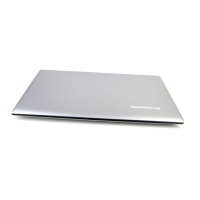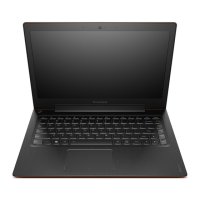Do you have a question about the Lenovo IdeaPad U510 and is the answer not in the manual?
Identifies components such as camera, display, keyboard, touchpad, and indicators on the computer's top.
Explains the use of function keys, hotkeys, and their impact on system settings and backlight.
Guides users on how to disable or enable the hotkey mode through the BIOS setup utility.
Details the Novo button, ventilation slots, RJ-45, MINI VGA, HDMI, USB 3.0, and combo audio jack.
Provides instructions on connecting and disconnecting USB devices, including driver installation and usage.
Details the USB 2.0 port, memory card slot, optical drive, and AC power adapter jack.
Explains how to insert and remove memory cards (SD, MMC) and notes on reader compatibility.
Illustrates the front view with indicators and the bottom view with cooling louvers.
Guides users through initial OS setup including license agreement, internet connection, and user account creation.
Explains the Start screen and Desktop interfaces and how to switch between them.
Details the five Windows 8 charms (Search, Share, Start, Devices, Settings) for quick tasks and system access.
Provides instructions on putting the computer to sleep and shutting it down safely.
Guides users on enabling wireless connection and connecting to available Wi-Fi networks.
Explains how to access Windows Help and Support files and online resources for assistance.
Step-by-step guide on how to back up the system partition to an image file.
Instructions on restoring the system partition to its original status or a previous backup point.
Answers common questions about finding information, hardware specifications, warranty, and software.
Addresses OneKey Recovery issues and guides on BIOS setup, including starting and changing boot modes.
Provides information on how to contact the customer support center for assistance.
Steps to resolve common display problems like blank screen, distorted visuals, or incorrect characters.
Troubleshooting for forgotten passwords, low battery warnings, and unexpected sleep mode entry.
Solutions for no sound, HDD not working, boot device issues, and external device connectivity problems.
Identifies components such as camera, display, keyboard, touchpad, and indicators on the computer's top.
Explains the use of function keys, hotkeys, and their impact on system settings and backlight.
Guides users on how to disable or enable the hotkey mode through the BIOS setup utility.
Details the Novo button, ventilation slots, RJ-45, MINI VGA, HDMI, USB 3.0, and combo audio jack.
Provides instructions on connecting and disconnecting USB devices, including driver installation and usage.
Details the USB 2.0 port, memory card slot, optical drive, and AC power adapter jack.
Explains how to insert and remove memory cards (SD, MMC) and notes on reader compatibility.
Illustrates the front view with indicators and the bottom view with cooling louvers.
Guides users through initial OS setup including license agreement, internet connection, and user account creation.
Explains the Start screen and Desktop interfaces and how to switch between them.
Details the five Windows 8 charms (Search, Share, Start, Devices, Settings) for quick tasks and system access.
Provides instructions on putting the computer to sleep and shutting it down safely.
Guides users on enabling wireless connection and connecting to available Wi-Fi networks.
Explains how to access Windows Help and Support files and online resources for assistance.
Step-by-step guide on how to back up the system partition to an image file.
Instructions on restoring the system partition to its original status or a previous backup point.
Answers common questions about finding information, hardware specifications, warranty, and software.
Addresses OneKey Recovery issues and guides on BIOS setup, including starting and changing boot modes.
Provides information on how to contact the customer support center for assistance.
Steps to resolve common display problems like blank screen, distorted visuals, or incorrect characters.
Troubleshooting for forgotten passwords, low battery warnings, and unexpected sleep mode entry.
Solutions for no sound, HDD not working, boot device issues, and external device connectivity problems.
| Bus type | DMI |
|---|---|
| Stepping | L1 |
| Tjunction | 105 °C |
| Processor cache | 3 MB |
| Processor cores | 2 |
| System bus rate | 5 GT/s |
| Processor family | Intel® Core™ i3 |
| Processor series | Intel Core i3-3200 Mobile Series |
| Processor socket | BGA 1023 |
| Processor threads | 4 |
| Processor codename | Ivy Bridge |
| Processor frequency | 1.8 GHz |
| Processor cache type | Smart Cache |
| Processor lithography | 22 nm |
| Processor manufacturer | Intel |
| Processor front side bus | - MHz |
| PCI Express slots version | 2.0 |
| Processor operating modes | 64-bit |
| ECC supported by processor | No |
| PCI Express configurations | 1x16, 2x8, 1x8+2x4 |
| Thermal Design Power (TDP) | 17 W |
| CPU multiplier (bus/core ratio) | 18 |
| Maximum number of PCI Express lanes | 16 |
| Motherboard chipset | Intel HM77 Express |
| Internal memory | 4 GB |
| Memory clock speed | 1600 MHz |
| Internal memory type | DDR3-SDRAM |
| Maximum internal memory | 8 GB |
| HDD speed | 5400 RPM |
| HDD capacity | 500 GB |
| SSD capacity | 24 GB |
| HDD interface | SATA |
| Storage media | HDD+SSD |
| Optical drive type | DVD Super Multi DL |
| Card reader integrated | Yes |
| Total storage capacity | 524 GB |
| Compatible memory cards | MMC, SD |
| Number of HDDs installed | 1 |
| Touchscreen | - |
| Display diagonal | 15.6 \ |
| Display resolution | 1366 x 768 pixels |
| Native aspect ratio | 16:9 |
| On-board graphics card ID | 0x166 |
| Discrete graphics card model | Not available |
| On-board graphics card model | Intel® HD Graphics 4000 |
| On-board graphics card family | Intel® HD Graphics |
| On-board graphics card base frequency | 350 MHz |
| On-board graphics card dynamic frequency (max) | 1050 MHz |
| Audio system | Dolby Home Theater v4 |
| Speaker power | 2 W |
| Data network | Not supported |
| Ethernet LAN data rates | 10, 100, 1000 Mbit/s |
| Charging port type | DC-in jack |
| USB 2.0 ports quantity | USB 2.0 ports have a data transmission speed of 480 Mbps, and are backwards compatible with USB 1.1 ports. You can connect all kinds of peripheral devices to them. |
| eSATA/USB 2.0 ports quantity | 0 |
| Pointing device | Touchpad |
| Operating system installed | Windows 8 |
| Form factor | Clamshell |
| Product type | Laptop |
| Product color | Black, Grey |
| Processor code | SR0N9 |
| Processor ARK ID | 65697 |
| Processor package size | 31 x 24 mm |
| Supported instruction sets | AVX |
| Intel Identity Protection Technology version | 1.00 |
| Battery life (max) | 6 h |
| Depth | 250 mm |
|---|---|
| Width | 382 mm |
| Height | 21 mm |
| Weight | 2200 g |











